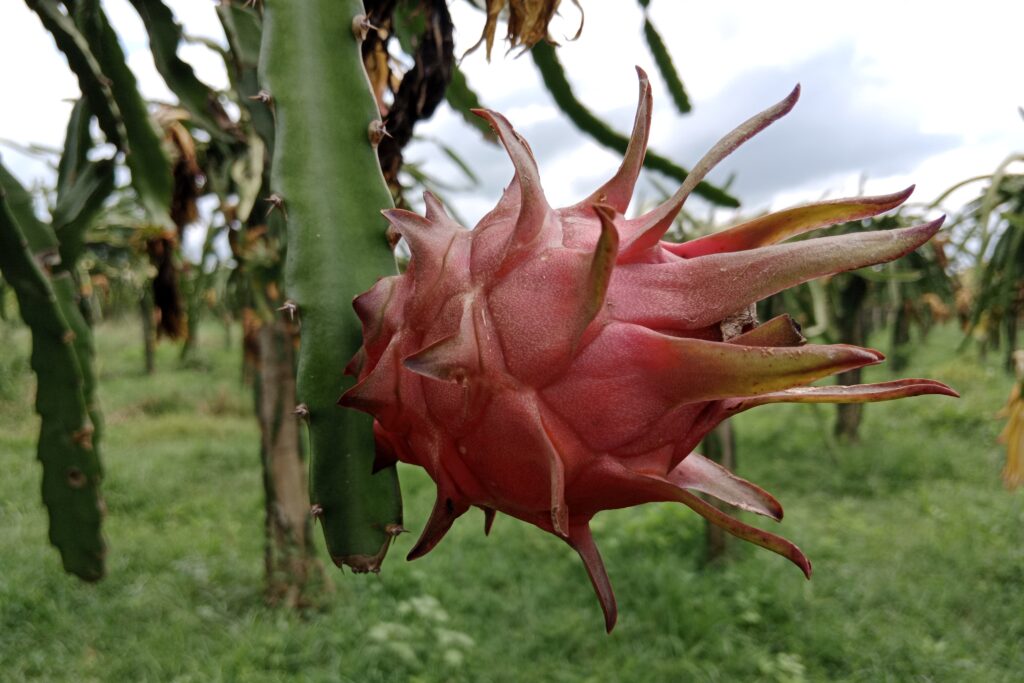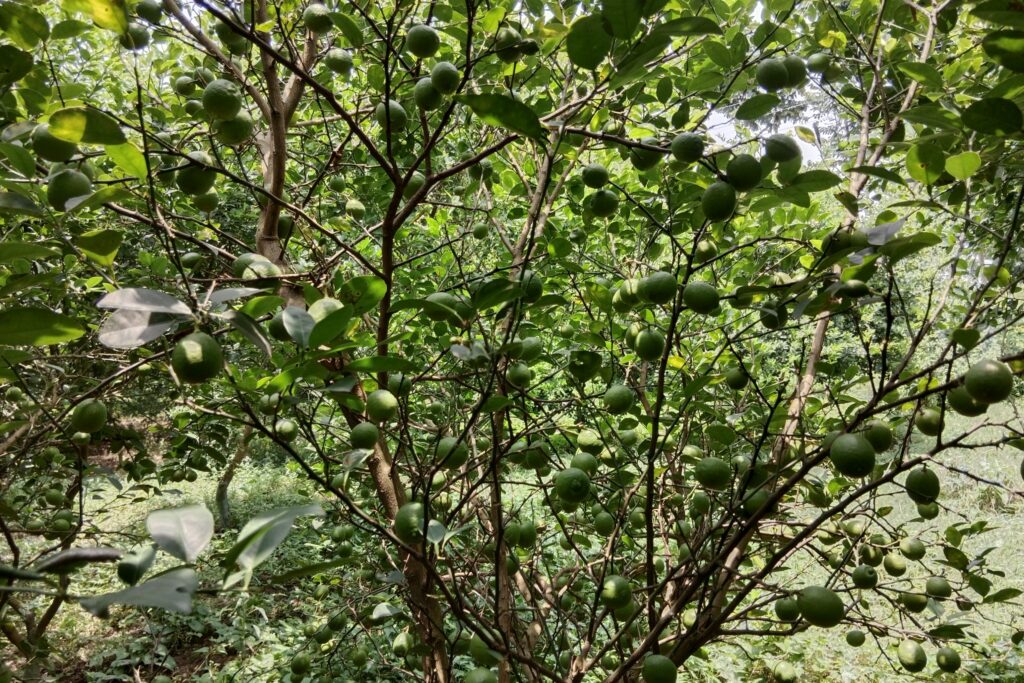Sorghum Farming Profit Per Acre
Sorghum (Sorghum bicolor) is a versatile, drought-tolerant cereal grain crop cultivated for food, fodder, biofuel, and industrial products. Originating in Africa, it is the fifth most important cereal crop globally. It is a staple food in many semi-arid regions due to its ability to thrive under harsh conditions where other crops fail.

Sorghum (Sorghum bicolor) is a versatile cereal crop widely cultivated for food, fodder, and industrial uses, particularly in semi-arid and tropical regions. Known for its exceptional drought tolerance and adaptability to diverse soils, it plays a vital role in ensuring food and nutritional security while supporting livestock feed and biofuel production.
With its ability to thrive under challenging climatic conditions and contribute to sustainable agriculture, sorghum has become an important crop for both smallholder farmers and commercial farming systems worldwide.
Sorghum farming profit per acre can be highly rewarding when managed with proper practices and market access. Based on recent estimates, the total investment cost per acre stands at NRs. 48,000, while the total income from grain and other outputs reaches around NRs. 102,000.
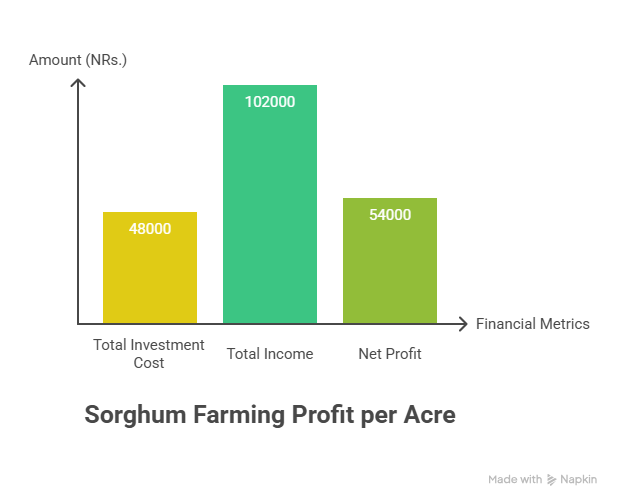
This results in a substantial net profit of NRs. 54,000 per acre. The profitability is further highlighted by the Return on Investment (ROI), which is calculated as (Net Profit ÷ Total Cost) × 100, giving an impressive 112.5%. Such figures clearly demonstrate that sorghum cultivation is not only cost-effective but also a highly lucrative farming option, where the returns more than double the initial investment.
Land Preparation
Land preparation aims to create a fine, firm, and weed-free seedbed that promotes good seed-to-soil contact and ensures uniform germination and emergence. It begins with deep plowing (or subsoiling in case of a hardpan) using a moldboard plow immediately after the previous harvest to turn over the soil and incorporate crop residues.
Following the first rain or irrigation, 2–3 shallow harrowings with a disc harrow are carried out to break down large clods and level the field. The final step involves planking or using a leveling board to achieve a fine tilth, conserve soil moisture, and ensure uniform water distribution when irrigation is applied.
Soil Type
Sorghum is a highly adaptable crop that grows best in well-drained, loamy soils with a balanced mix of sand, silt, and clay. It can tolerate a wide pH range from 5.5 to 8.5 but performs optimally in neutral conditions between 6.0 and 7.5. The crop is moderately tolerant to salinity and alkalinity; however, poorly drained heavy clay soils are unsuitable as they often cause waterlogging and root rot.
Climatic Requirements
Sorghum is a warm-season crop that grows best at temperatures between 25°C and 32°C (77°F–90°F) and is highly sensitive to frost, making it unsuitable for low-temperature conditions during its growth period. Known for its drought tolerance, sorghum thrives with 400–600 mm (16–24 inches) of well-distributed rainfall throughout the growing cycle, although excessive rain during flowering can hinder pollination. Additionally, the crop requires full sunlight to support optimal photosynthesis and healthy growth.
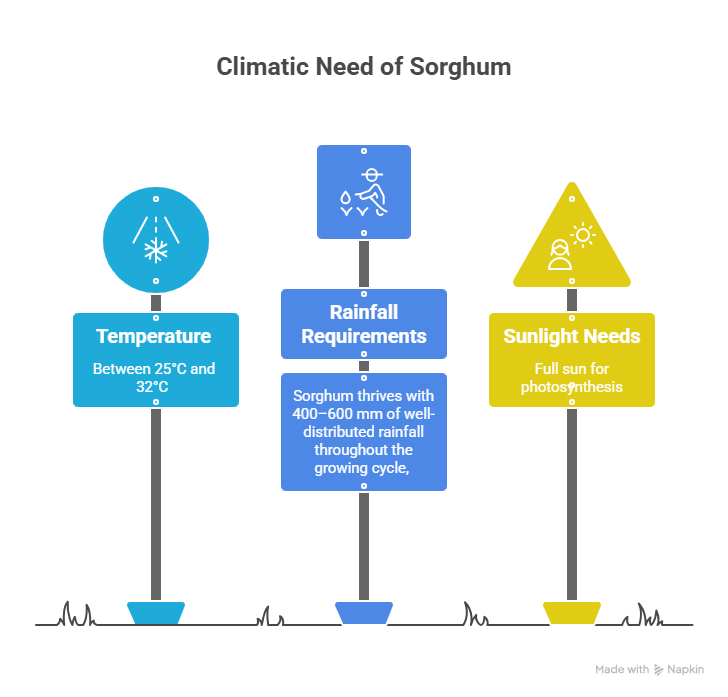
Major Cultivars
Cultivars are selected according to their intended use, whether for grain production, syrup extraction, forage for livestock, or biofuel generation.
| Cultivar Type | Primary Purpose | Key Characteristics | Examples |
| Grain Sorghum | Grain production | Bicolor-type varieties with hard, large seeds | CSV series, Pioneer, Dekalb brands, SL44, Punjab Sudax, Pusa Chari |
| Sweet Sorghum | Syrup, Jaggery, Biofuel | Tall varieties with juicy, sugar-rich stalks | SSV, Sugar graze, Keller |
| Forage Sorghum | Silage, Green Fodder | Tall, high-biomass varieties with sweet, juicy stems | Jowar giant, Sudan grass hybrids |
| Broomcorn | Making Brooms | Specialized varieties with long, fibrous panicles |
Propagation
Sorghum is propagated exclusively by seeds. Using certified, high-quality seeds from a reliable source is crucial for good yield and disease resistance.
Seed Rate per Acre
| Purpose / Planting Method | Seed Rate (kg/acre) | Notes |
| Grain Production (Drilled in rows) | 8 – 10 kg | Standard recommended method for even plant stand. |
| Forage Production (Drilled) | 12 – 15 kg | Higher density is used to maximize biomass for fodder. |
| Broadcasting (for grain) | 12 – 15 kg | This method is not recommended as it leads to uneven plant stands and inefficient seed use. |
For effective protection against soil-borne diseases, seeds should be treated before sowing with 300-mesh sulphur powder at 4 g per kg of seed, followed by Azotobacter at 25 g per kg of seed. Additionally, one fungicide can be used per kg of seed, choosing from Carbendazim (2 g) or Thiram (2 g) to ensure healthy crop establishment.
Nursery Management
Direct seeding is the standard practice for sorghum. A nursery and transplanting are generally not used for large-scale commercial grain production as it is not economical. However, it may be practiced on a small scale for very early season production or in home gardens to extend the growing season.
Planting
a). Planting Season
The timing of planting is a critical management decision, as it must align the crop’s most sensitive growth stages with optimal weather conditions; the two primary seasons are the Kharif or rainy season, which is the most common and involves sowing with the onset of the monsoon in June and July, and the summer season, which requires sowing in January and February with assured irrigation.
b). Spacing
For sorghum cultivation, the recommended spacing is 45–60 cm between rows and 15–20 cm between plants after thinning, with wider spacing preferred in drier regions to minimize competition for water.
c). Planting Method
| Method | Description | Key Characteristics |
| Drilling | Using a seed drill or planter to place seeds at a uniform depth and spacing in rows. | Most efficient and recommended method. Ensures optimal plant population and ease of inter-cultural operations. |
| Dibbling | Making small holes at the recommended spacing, placing 2-3 seeds per hole, and covering them with soil. | Used primarily in small areas or where machinery is unavailable. Requires subsequent thinning. |
| Broadcasting | Scattering seeds manually across the field followed by light harrowing to cover them. | Leads to an uneven plant stand. Not recommended due to inefficient seed use and difficulty in weed control. |
d). Number of Plants per Acre
At a spacing of 45 cm × 15 cm, sorghum cultivation results in an average plant population of about 59,955 plants per acre.
Intercropping
Sorghum is highly suitable for intercropping, as it maximizes land use and reduces risk, and is commonly grown alongside legumes such as pigeon pea (arhar), cowpea, green gram (mung bean), or black gram (urad bean). The usual pattern involves alternating 2–4 rows of sorghum with 1–2 rows of legumes, which not only optimize space but also enrich the soil through nitrogen fixation, thereby benefiting the sorghum crop.
Irrigation
Although sorghum is drought-tolerant, adequate moisture is essential at critical growth stages. The first irrigation should be applied immediately after sowing if the crop is not rain-fed, while subsequent irrigations are crucial during tillering, flowering, and the soft dough stages. Typically, 4–5 irrigations are sufficient for a summer crop, with frequency varying based on soil type and rainfall, and care should be taken to avoid waterlogging.
Fertilizer and Manure
For the most accurate and efficient results, always base fertilizer application on a soil test report.
| Category | Specific Input | Recommended Rate | Application Method & Timing |
| Organic Manure | Well-decomposed FYM or Compost | 4 – 5 tonnes | Apply uniformly and mix into the soil during the last stage of land preparation. |
| Biofertilizers | Azospirillum | 800 grams | These are best applied by mixing with the seeds just before sowing or by mixing with organic manure. |
| Phosphobacteria (PSB) | 800 grams | ||
| Potash Mobilizing Bacteria | 800 grams | ||
| Inorganic Fertilizers | Nitrogen (N) | 40 – 50 kg (90 – 110 kg Urea) | Split Application: • Half (20-25 kg) applied as a basal dose at sowing. • The remaining half (20-25 kg) applied at the tillering stage (30-35 days after sowing). |
| Phosphorus (P₂O₅) | 20 – 25 kg (125 – 155 kg SSP) | Apply full amount as a basal dose during sowing. Place it near the seed for better uptake. | |
| Potash (K₂O) | 20 – 25 kg (35 – 40 kg MOP) | Apply only if soil tests show deficiency. Apply full amount as a basal dose during sowing. |
Weed Control
Weed control is crucial in sorghum, especially during the first 30–45 days when weeds compete intensely for water and nutrients. It can be managed through cultural practices such as inter-row hoeing and weeding, mechanical methods like wheel hoeing or hand weeding, and chemical control by applying pre-emergence herbicides such as Atrazine at 0.5 kg/acre immediately after sowing, following all label instructions carefully.
Flowering and Fruit Management
Sorghum is a predominantly self-pollinating crop where the head, or panicle, emerges from the boot of the flag leaf and flowering, known as anthesis, progresses downward from the top of the panicle.
While no specific fruit management is required, this period of flowering and the subsequent grain filling stage is critically sensitive; stress from factors such as drought or nutrient deficiency at this time can drastically reduce yield. Consequently, the key management practice is to ensure the crop receives adequate water and nutrients throughout this phase to safeguard the developing grain.
Pest and Disease Management
Common Pests
a) Shoot Fly
Shoot fly larvae attack young sorghum seedlings, causing the characteristic “dead heart” symptom, where the central shoot dries and dies. Management includes using resistant varieties, adjusting the sowing time to avoid peak fly activity, and treating seeds with Imidacloprid at 4–5 ml per kg of seed before sowing.
b) Stem Borer
Stem borer larvae bore into the sorghum stem, leading to dead hearts in young plants or stem breakage in older plants. Effective management strategies include releasing Trichogramma wasps as a biological control and spraying chemical insecticides such as Carbaryl 50 WP at 2 g per liter of water or Chlorpyriphos 20 EC at 2 ml per liter of water when infestation is noticed.
c) Aphids
Aphids feed on the sap of sorghum leaves, causing stunted growth and reduced yield. They can be controlled by encouraging natural predators like ladybugs, or by spraying Imidacloprid 17.8 SL at 0.3 ml per liter of water or Dimethoate 30 EC at 1.5 ml per liter of water when populations reach the economic threshold.
d) Head Bugs and Midge
These pests feed on developing grains, reducing grain quality and yield. Management involves timely application of insecticides during the flowering stage, using recommended products such as Imidacloprid 17.8 SL at 0.3 ml per liter or Lambda-cyhalothrin 5 EC at 0.5 ml per liter, ensuring proper coverage of the panicles.
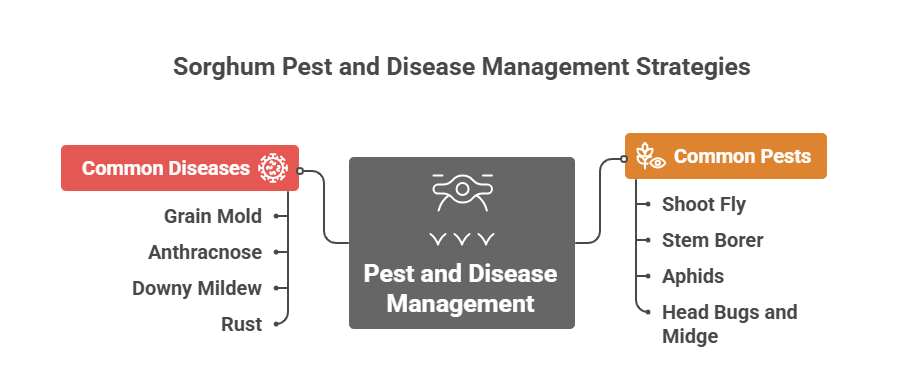
Common Diseases
a). Grain Mold
This disease occurs when wet, humid weather persists during the grain maturation stage. It leads to discolored, damaged grains, reducing both yield and quality. Effective management strategies include planting resistant varieties, avoiding late planting to ensure grains dry under sunny conditions, and harvesting the crop promptly as soon as it matures. While fungicides are not typically used for mold on mature grain, applying a foliar fungicide like Propiconazole 25% EC (1 ml per liter of water) at the flowering stage can help protect the developing panicle in areas expecting prolonged wet weather.
b). Anthracnose
Anthracnose is a fungal disease that causes distinctive red or purple lesions with tan centers on leaves and can lead to severe stalk rot and lodging. An integrated approach to management is crucial. This includes practicing crop rotation with non-host crops and always using certified, fungicide-treated seeds. If disease symptoms appear, a foliar application of Mancozeb 75% WP (2 to 2.5 grams per liter of water) is recommended. Spray at the first sign of disease and repeat as needed, following a 10-15 day interval.
c). Downy Mildew
This disease causes chlorosis, or yellowing, of the leaves along with white, downy fungal growth on the undersides. It can stunt plant growth and severely impact yield. The primary management method is to use genetically resistant varieties. For prevention, seed treatment is highly effective. Treat seeds with Metalaxyl 35% SD (at a rate of 4-6 grams per kilogram of seed) before sowing to systemically protect the young seedlings from infection.
d). Rust
Rust is characterized by small, raised reddish-brown pustules that mainly develop on leaves, reducing the plant’s ability to photosynthesize. The most reliable and cost-effective way to manage this disease is by cultivating resistant varieties. In case of an outbreak, applying fungicides at the first sign of infection can help contain its spread. A foliar spray of Propiconazole 25% EC (1 ml per liter of water) should be used, ensuring complete coverage of the leaf surface for effective control.
Harvesting
The timing of harvest depends on the intended use:
| Purpose | Optimal Harvest Time / Indicators | Key Characteristics |
| For Grain | 100-120 days after sowing. When grains are hard and at physiological maturity (30-40% moisture). | The plant appears dry. Grains are difficult to puncture with a thumbnail. |
| For Fodder | At the boot stage (just before the seed head emerges from the whorl). | This timing provides the best balance of high nutrient quality and palatability for animal feed. |
| For Silage | When the grain is at the soft dough stage. | Provides the ideal moisture level and sugar content necessary for proper fermentation in the silo. |
| Method | Manual: Using sickles. Mechanical: Using combine harvesters. | Manual methods are for small-scale farms. Combines are efficient for large-scale operations. |
Yield
The yield of sorghum varies widely depending on the cultivar, season, and management practices. Under rain-fed conditions, grain yield generally ranges from 800 to 1200 kg per acre, while improved hybrids with proper irrigation and optimal management can produce 1600 to 2000 kg per acre. In addition, sorghum provides 15 to 25 tonnes per acre of green fodder and 20 to 30 tonnes per acre of sweet sorghum stalk yield.
Similar Article: Wheat Farming Profit Per Acre
Cost of Investment per Acre for Sorghum Farming
| S.N. | Categories | Cost (NRs.) |
| 1 | Land Preparation | 15,000 |
| 2 | Seed | 1,000 |
| 3 | Sowing | 1,000 |
| 4 | Fertilizers and Manure | 6,000 |
| 5 | Irrigation | 5,000 |
| 6 | Weed Control | 5,000 |
| 7 | Pest & Disease Control | 5,000 |
| 8 | Harvesting | 5,000 |
| 9 | Miscellaneous Costs | 5,000 |
| Total Investment Cost | 48,000 |
Income per Acre from Sorghum Farming
| Product | Estimated Yield (Kg) | Market Price (NRs./Kg) | Total Income (NRs.) |
| Grain Yield | 1,200 | 60 | 72,000 |
| Straw Yield | 3,000 | 10 | 30,000 |
| Total Income | 102,000 |
Analysis of Sorghum Farming Profit Per Acre
The net profit from the sorghum farming venture is calculated by subtracting the total investment cost of NRs. 48,000 from the total income of NRs. 102,000, resulting in a net profit of NRs. 54,000. This profitability is further emphasized by the Return on Investment (ROI) calculation, which is determined by the formula (Net Profit / Total Cost) × 100, yielding an impressive ROI of 112.5%. This indicates a highly successful investment where the returns significantly exceed the initial capital outlay.
Crop Calendar of Sorghum Farming
| Growth Stage | Time After Sowing (Approx.) | Key Activities & Management Practices |
| Land Preparation | 2-3 weeks before sowing | Clear previous crop residues. Perform deep plowing followed by 2-3 harrowings to achieve a fine tilth. Apply and incorporate well-decomposed FYM (4-5 tonnes/acre) during the last plowing. |
| Sowing | Day 0 | Kharif Season: Sow with onset of monsoon (Jun-Jul). Rabi/Summer: Sow with assured irrigation (Sep-Oct / Jan-Feb). Method: Drill seeds at 2-3 cm depth with 45-60 cm row spacing. |
| Germination & Emergence | 3 – 7 days | Ensure adequate soil moisture for uniform germination. |
| Seedling Stage | 1 – 3 weeks | Thinning: (At 15-20 days) Thin plants to maintain 10-15 cm spacing. Weed Control: Apply pre-emergence herbicide or perform first manual weeding. |
| Vegetative Stage (Tillering) | 3 – 5 weeks | First Top-Dressing: Apply the remaining half dose of Nitrogen fertilizer. Weed Control: Perform second weeding and earthing up. Irrigation: Critical stage; ensure no moisture stress. |
| Stem Elongation | 5 – 8 weeks | Monitor for pests like stem borer. Apply necessary control measures. |
| Panicle Initiation | 7 – 9 weeks | This is a crucial growth stage. Ensure adequate water and nutrient availability. |
| Flowering (Anthesis) | 8 – 10 weeks | Critical Stage: Avoid any water stress as it directly impacts grain yield. Irrigation is essential if dry spells occur. Monitor for head bugs and midges. |
| Grain Filling (Dough Stage) | 10 – 13 weeks | Critical Stage: Continue irrigation to ensure plump grains. Monitor for grain molds if weather is wet and humid. |
| Physiological Maturity | 13 – 16 weeks (100-120 days) | Grains harden, moisture content drops to ~25-30%. Leaves and stalks start to dry. |
| Harvesting | 16 – 18 weeks | Harvest when grains are hard and difficult to puncture with a thumbnail. Cut the panicles and stalks manually or with a combine harvester. |
| Post-Harvest | After harvesting | Threshing: Separate grains from the panicles. Drying: Sun-dry grains to reduce moisture content to 12-13% for safe storage. Storage: Store in a cool, dry place in airtight containers to prevent pest infestation. |
Sources
Food and Agriculture Organization (FAO)
University of California Agriculture & Natural Resources (UC ANR)
European Plant Protection Organization (EPPO)
Punjab Agricultural University (PAU)
Tamil Nadu Agriculture University (TNAU) – Agritech portal
Indian Council of Agricultural Research (ICAR)
Nepal Agricultural Research Council (NARC)
U.S. Department of Agriculture (USDA).
Ministry of Agriculture and Livestock Development (Nepal)
Disclaimer: This crop farming profits assume optimal conditions. Actual results may vary depending on climate, market prices, and farm management practices.

